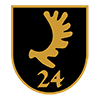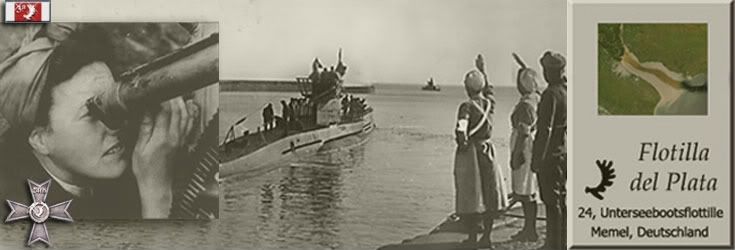Disculpen que puse todo el artículo en inglés pero no se lo suficiente como para traducirlo, para entenederlo yo es diferente.
Pueden pintarlo, darle copiar e ir a herramientas del idioma con Google Algunas palabras no serán exactas, pero lo arregla un diccionario. Saludos
Personal information
Wolfgang Lüth began his naval career in April 1933 after studying law for three semesters. In the summer of 1933 he spent the traditional three months on the sailing school ship Gorch Fock and then went on a 9-month training tour around the world (India, Indonesia, Australia, North and South America) on the light cruiser Karlsruhe. After a year on the light cruiser Königsberg he transferred to the U-boat force in February 1937.
In July 1937 he became II WO on U-27 and made one patrol in Spanish waters during the Spanish Civil War. In October 1937 he became I WO on U-38 under Kptlt. Heinrich Liebe and was on patrol in September 1939 when the war began.
After a short time on a school boat he took over the Type IIB U-boat U-9. During six patrols with this boat he achieved his first successes, most notably the sinking of the French submarine Doris in May 19
A month later Oberleutnant Wolfgang Lüth commissioned the IID U-boat U-138. During the night of 20/21 September, 1940, on his first patrol with the new boat, he sank four ships for a total of 34,633 tons - a great coup for such a small boat.
In October 1940, after returning from his second patrol, where he sank one more ship and damaged another, he received the Knights Cross, being the only commander of a small U-boat to win that decoration.
He left U-138 that month and took over the larger U-43. He made five patrols with this boat and sank 12 ships for a total of 68,077 tons. In April 1942 he left U-43 and in May 1942 commissioned the IXD 2 U-boat U-181.
In September 1942 Kptlt. Lüth left Kiel for his first patrol with this boat. The operational area included the Indian Ocean as well as South African waters. He reached Capetown, South Africa at the end of October , and during the next two weeks sank four ships for a total of 21,987 tons. On 16 November he received a radio message announcing he had received Oak Leaves to the Knights Cross. Before he headed back, in the following two weeks he sank eight further ships for a total of 36,394 tons. He reached Bordeaux, France in January 1943.
In March 1943 Kptlt. Lüth left Bordeaux for a further patrol in African waters and the Indian Ocean. This patrol, under difficult conditions, was also very successful with ten ships sunk for a total of 45,331 tons. During this patrol Lüth became the first U-boat officer to receive the Knights Cross with Oak Leaves, Swords and Diamonds.
This patrol was also outstanding because it was the second longest patrol in the war (and likely in the entire history of the submersibles), lasting 205 days, second only to Kentrat's incredible 225 days on U-196.
During this patrol, to maintain morale, Lüth pioneered various ideas such as publishing his own boat's newsletter, holding contests of various types, and many other activities designed to keep the crew mentally and physically alert.
He spoke about this topic during a conference of Navy staff officers in Weimar on 17 December, 1943, providing a fascinating description of the psychological problems which could arise due to the extreme length of such a patrol. (The entire text appears in Tarrant's The U-Boat Offensive 1939 - 1945.)
n January 1944, after more than 5 years of uninterrupted duty on U-boats, the highly decorated Korvettenkapitän Wolfgang Lüth became the commander of the 22nd flotilla, where future U-boat commanders were trained.
In July 1944 he became commander of the I. Abteilung (1st Department) of the Marineschule in Flensburg-Mürwik, where future German Kriegsmarine officers were taught. In September 1944 Lüth became the youngest commander of the German Marineschule in history.
But only a few days after the war ended, he died in an unfortunate accident. Kapitän zur See Wolfgang Lüth was shot on 13 May, 1945, by a German sentry when he failed to identify himself or give the password. The lucky shot, fired by the sentry at a target he could not even see in the darkness, struck Lüth in the head, killing him instantly.
There has been much speculation as to why he did not respond to the sentry's challenge. Some have suggested it was deliberate suicide, others that Lüth responded but the sentry failed to hear him. The most likely explanation is that he was drunk, exhausted, or otherwise distracted as he made his way across the grounds of the Marineschule shortly after midnight on the fourth day after Germany's surrender.
Lüth was one of the most controversial of all the U-boat commanders, first and foremost because he publicly advertised his firm belief in the tenets of Nazism. But other aspects of his personality and even his successes have found their detractors. Although he sank a vast amount of tonnage, his successes occurred mostly in African waters and in the Indian Ocean, areas which offered relatively easy pickings and few enemy defenses as compared with the situation in the North Atlantic. Some of his contemporaries found his ideas on crew management naïve and even laughable; commanders who endured frequent, hair-raising attacks from the aircraft and escort vessels that dogged them in northern waters could not relate to the problem of needing to keep crews amused during monotonous patrols. Buchheim's Das Boot ridicules Lüth's famous lecture on "Problems of Leadership in a Submarine" (although the lecture actually occurred two years after the events in the book were supposed to have taken place, it is clear what Buchheim means when he pokes fun at a long text from "a speech by Lieutenant-Commander L.").
Lüth's paternalistic attitude toward his crewmen was also well known; not only did he believe it his duty as a leader to be interested in the well-being of his men even after they had left his boat, he also controlled their personal habits as much as possible. All reading materials brought on board had to gain Lüth's personal approval, and pinup posters were forbidden, part of a campaign to stamp out "sexual problems on board". He actively promoted his theories about the proper way to maintain physical health on patrol, going so far as to require certain items of clothing to be worn, and forbidding or closely regulating the consumption of certain foods, drinks, and cigarettes. However, Lüth's fatherly style seems to have evoked lifelong loyalty among the majority of his crewmen, who revere him to this day. He also continued to aid his men in their personal affairs and careers after he left U-181, taking time from his busy administrative schedule to respond to their requests for help.
Clearly he was a true leader of men, similar in this respect to Großadmiral Dönitz, who stated after the war that Lüth had been designated for the position of BdU. However, due to his political leanings, had Lüth survived he would undoubtedly have served a long term in Allied captivity and might even have been barred from serving in a leadership position after his release.
Two days after his death, Lüth received the last state funeral of the Third Reich. Six U-boat officers decorated with the Knights Cross formed the honor guard, and Dönitz spoke the last words. To this day, a memorial stone serves to preserve the memory of this outstanding U-boat officer.
Patrol info for Wolfgang Lüth
U-boat Departure Arrival
1. U-9
16 Jan 1940 Kiel 22 Jan 1940 Wilhelmshaven Patrol 1, 7 days
2. U-9
5 Feb 1940 Wilhelmshaven 14 Feb 1940 Helgoland Patrol 2, 10 days
3. U-9
17 Feb 1940 Helgoland 17 Feb 1940 Wilhelmshaven Patrol 2, 1 days
4. U-9
14 Mar 1940 Wilhelmshaven 20 Mar 1940 Wilhelmshaven Patrol 3, 7 days
5. U-9
4 Apr 1940 Wilhelmshaven 24 Apr 1940 Kiel Patrol 4, 21 days
6. U-9
5 May 1940 Kiel 15 May 1940 Wilhelmshaven Patrol 5, 11 days
7. U-9
16 May 1940 Wilhelmshaven 30 May 1940 Kiel Patrol 6, 15 days
8. U-138
10 Sep 1940 Kiel 26 Sep 1940 Lorient Patrol 7, 17 days
9. U-138
8 Oct 1940 Lorient 19 Oct 1940 Lorient Patrol 8, 12 days
10. U-43
10 Nov 1940 Lorient 17 Dec 1940 Lorient Patrol 9, 38 days
11. U-43
11 May 1941 Lorient 1 Jul 1941 Lorient Patrol 10, 52 days
12. U-43
2 Aug 1941 Lorient 23 Sep 1941 Lorient Patrol 11, 53 days
13. U-43
10 Nov 1941 Lorient 16 Dec 1941 Lorient Patrol 12, 37 days
14. U-43
30 Dec 1941 Lorient 22 Jan 1942 Kiel Patrol 13, 24 days
15. U-181
12 Sep 1942 Kiel 18 Jan 1943 Bordeaux Patrol 14, 129 days
16. U-181
23 Mar 1943 Bordeaux 14 Oct 1943 Bordeaux Patrol 15, 206 days
15 patrols, 640 days at sea
Ships hit by Wolfgang Lüth
Date Boat Name of ship Tons Nat. Convoy Fate *
18 Jan, 1940 U-9
Flandria
1,179
sw
19 Jan, 1940 U-9
Patria
1,188
sw
11 Feb, 1940 U-9
Linda
1,213
es
4 May, 1940 U-9
San Tiburcio [Mine]
5,995
br
9 May, 1940 U-9
Doris (Q 135)
552
fr
11 May, 1940 U-9
Tringa
1,930
br
11 May, 1940 U-9
Viiu
1,908
es
23 May, 1940 U-9
Sigurd Faulbaum
3,256
be
20 Sep, 1940 U-138
Boka
5,560
pa OB-216
20 Sep, 1940 U-138
City of Simla
10,138
br OB-216
20 Sep, 1940 U-138
New Sevilla
13,801
br OB-216
21 Sep, 1940 U-138
Empire Adventure
5,145
br OB-216
15 Oct, 1940 U-138
Bonheur
5,327
br OB-228
15 Oct, 1940 U-138
British Glory
6,993
br OB-228
damaged
2 Dec, 1940 U-43
Pacific President
7,113
br OB-251
2 Dec, 1940 U-43
Victor Ross
12,247
br OB-251
6 Dec, 1940 U-43
Skrim
1,902
nw OB-252
13 Dec, 1940 U-43
Orari
10,350
br damaged
15 May, 1941 U-43
Notre Dame du Châtelet
488
fr
6 Jun, 1941 U-43
Yselhaven
4,802
nl OB-328
17 Jun, 1941 U-43
Cathrine
2,727
br SL-76
29 Nov, 1941 U-43
Thornliebank
5,569
br OS-12
30 Nov, 1941 U-43
Ashby
4,868
br OS-12
2 Dec, 1941 U-43
Astral
7,542
am
12 Jan, 1942 U-43
Yngaren
5,246
sw HX-168
14 Jan, 1942 U-43
Chepo
5,707
pa ON-55
14 Jan, 1942 U-43
Empire Surf
6,641
br ON-55
3 Nov, 1942 U-181
East Indian
8,159
am
8 Nov, 1942 U-181
Plaudit
5,060
pa
10 Nov, 1942 U-181
K.G. Meldahl
3,799
nw
13 Nov, 1942 U-181
Excello
4,969
am
19 Nov, 1942 U-181
Gunda
2,241
nw
20 Nov, 1942 U-181
Corinthiakos
3,562
gr
22 Nov, 1942 U-181
Alcoa Pathfinder
6,797
am
24 Nov, 1942 U-181
Dorington Court
5,281
br
24 Nov, 1942 U-181
Mount Helmos
6,481
gr
28 Nov, 1942 U-181
Evanthia
3,551
gr
30 Nov, 1942 U-181
Cleanthis
4,153
gr
2 Dec, 1942 U-181
Amarylis
4,328
pa
11 Apr, 1943 U-181
Empire Whimbrel
5,983
br
11 May, 1943 U-181
Tinhow
5,232
br DN-37
27 May, 1943 U-181
Sicilia
1,633
sw
7 Jun, 1943 U-181
Harrier
193
sa
2 Jul, 1943 U-181
Hoihow
2,798
br
15 Jul, 1943 U-181
Empire Lake
2,852
br
16 Jul, 1943 U-181
Fort Franklin
7,135
br
4 Aug, 1943 U-181
Dalfram
4,558
br
7 Aug, 1943 U-181
Umvuma
4,419
br DN-54
12 Aug, 1943 U-181
Clan Macarthur
10,528
br DN-55
243,099
* Unless otherwise noted the ships listed here were sunk.
[Mine] indicates the vessel was hit by a mine.

















